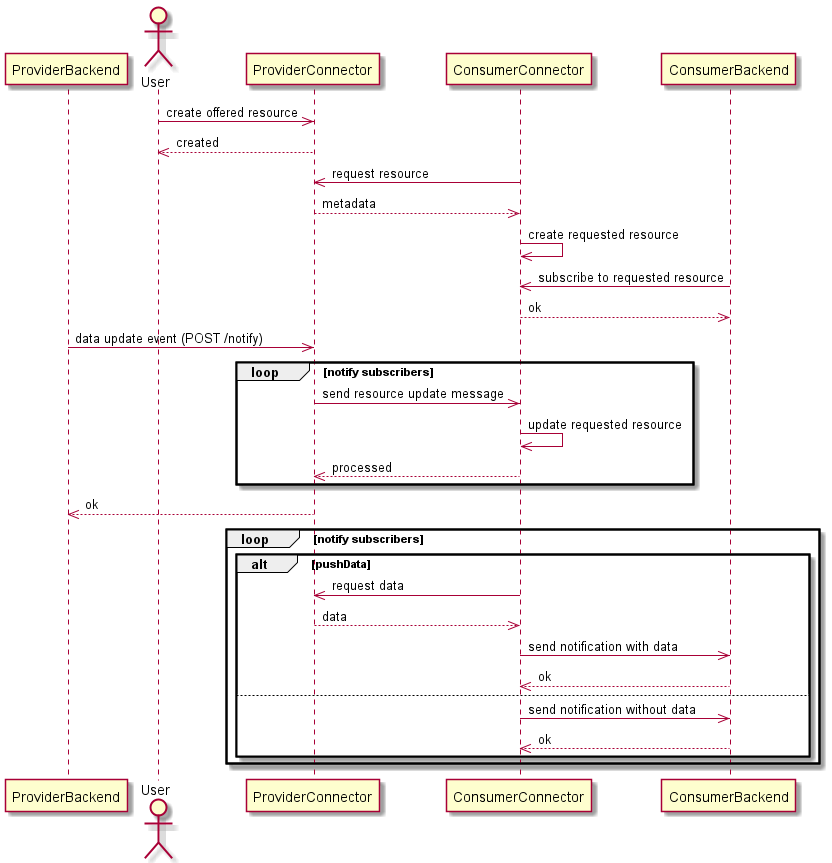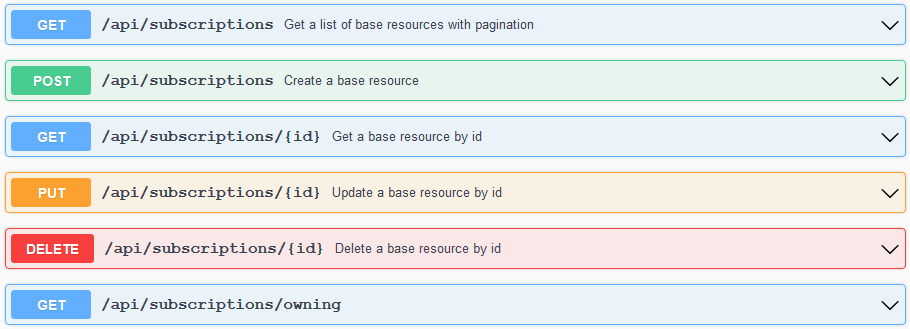Subscription
See how to subscribe to resources as IDS or non-IDS system.
Using the Dataspace Connector, the data exchange between data provider and consumer is always initiated by the consumer connector asking for metadata and then pulling the data. In some use cases, the data on the provider side is regularly updated. These updates must be propagated all the way to the consumer, both connector and data processing service in the background.
The consumer already has the ability to send parameterized queries to potentially filter the retrieved data, e.g. for a specific time period. Nevertheless, until Dataspace Connector v5, the consumer has to periodically pull to detect a data update because there was no way for the consumer connector to notify a connected backend in an event-driven manner. Also, notifying about updates from provider to consumer connector was quite a complicated task to be done by manually triggering the sending of IDS ResourceUpdateMessages.
The subscription process implemented in v6 actually does the same thing. However, a provider backend does not need to remember which consumer has subscribed and who needs to be notified at which address. Instead, the Dataspace Connector persists this information and sends out notifications automatically.

The subscription mechanism follows webhook patterns: a subscriber creates a request that includes where a response is expected. The current implementation does not allow defining a protocol. Per default, http POST requests are made.
Note: If you would like to keep an open connector for receiving updates via e.g. MQTT, a custom service could offer this functionality and listen to events from the Dataspace Connector, as this does not offer such a functionality by now.
In the Dataspace Connector, a subscription can be created by using a json object:
{
"title": "string",
"description": "string",
"target": "uri",
"location": "uri",
"subscriber": "uri",
"pushData": true
}
A title and description offer further information and can be added optionally. The target points to the object that should be watched. As an IDS subscriber, this can be an offer, a representation, or an artifact. As a non-IDS subscriber, subscriptions can be created for requests, representations, or artifacts.
The location represents e.g. a URL that expects the notification. The subscriber URI uniquely identifies the subscribing system. The boolean pushData states whether the data should be directly pushed to the subscriber or not.
Example
In the following example, it is assumed that the contract negotiation and an initial data exchange has already been set up. So how to propagate a data update from the provider’s backend to the consumer’s backend now?
Step 1: Create a non-IDS subscription
A custom service on the consumer side should be notified about updates of requested resources. The connector’s administrator does not want the application or service to access all REST endpoints. Thus, the application uses the application account defined in the application.properties.
spring.security.app.name=...
spring.security.app.password=...
Subscriptions can be managed with the provided CRUD endpoints.

Subscriptions will be automatically added to the respective target entity via a POST request. As described above, subscriptions can point at requests, representations, and artifacts. All subscriptions for an entity can be accessed via a separate endpoint. The location field found in the subscription object is where the connector will send a message to.
Once a subscription on an artifact exists the consumer will be notified when the artifact has been updated (for instance if the title is updated). A request is then set to the url specified in the subscription location field. When creating this subscription, a subscription is also created in the providers side, with its target being the same URI as the specified by the consumer but with the location being the consumers ids endpoint (https://consumer.com/api/ids/data). Create subscription:
curl -X 'POST' \
'https://localhost:8080/api/subscriptions' \
-H 'accept: */*' \
-H 'Content-Type: application/json' \
-d '{
"title": "Example",
"description": "Notify on update",
"target": "https://localhost:8080/api/requests/3660e95a-41bf-488b-8bff-3bfe7c19b633",
"location": "https://backend/event",
"subscriber": "https://customBackend",
"pushData": true
}'
Response:
{
"creationDate": "2021-08-02T14:30:31.921+0200",
"modificationDate": "2021-08-02T14:30:31.921+0200",
"target": "https://localhost:8080/api/requests/3660e95a-41bf-488b-8bff-3bfe7c19b633",
"location": "https://backend/event",
"subscriber": "https://customBackend",
"pushData": true,
"idsProtocol": false,
"additional": {},
"_links": {
"self": {
"href": "https://localhost:8080/api/subscriptions/120665fa-7156-49f5-b0cc-952b1bf64228"
}
}
}
GET https://localhost:8080/api/requests/3660e95a-41bf-488b-8bff-3bfe7c19b633/subscriptions:
{
"_embedded": {
"subscriptions": [
{
"creationDate": "2021-08-02T14:30:31.921+0200",
"modificationDate": "2021-08-02T14:30:31.921+0200",
"target": "https://localhost:8080/api/requests/3660e95a-41bf-488b-8bff-3bfe7c19b633",
"location": "https://backend/event",
"subscriber": "https://customBackend",
"pushData": true,
"idsProtocol": false,
"additional": {},
"_links": {
"self": {
"href": "https://localhost:8080/api/subscriptions/120665fa-7156-49f5-b0cc-952b1bf64228"
}
}
}
]
},
"_links": {
"self": {
"href": "https://localhost:8080/api/requests/3660e95a-41bf-488b-8bff-3bfe7c19b633/subscriptions?page=0&size=30"
}
},
"page": {
"size": 30,
"totalElements": 1,
"totalPages": 1,
"number": 0
}
}
Step 2: Create an IDS subscription
For subscribing as an IDS consumer connector to an IDS provider connector, other endpoints are provided:

As a body, the same subscription object is expected, with only a small difference. When creating an IDS subscription, the target URI has to be the URI of the provider’s artifact (not the URI persisted in the consumer side when requesting the resource). As described above, IDS subscribers can subscribe to offers, representations, and artifacts.
curl -X 'POST' \
'https://localhost:8080/api/ids/subscribe?recipient=https%3A%2F%2Flocalhost%3A8080%2Fapi%2Fids%2Fdata' \
-H 'accept: */*' \
-H 'Content-Type: application/json' \
-d '{
"title": "IDS Example",
"description": "Notify on update",
"target": "https://localhost:8080/api/offers/3660e95a-41bf-488b-8bff-3bfe7c19b633",
"location": "https://localhost:8080/api/ids/data",
"subscriber": "https://localhost:8080",
"pushData": false
}'
Response: 200 Successfully subscribed to ...
For IDS communication, custom IDS RequestMessages are used. An example is shown below:
Header:
{
"@context" : {
"ids" : "https://w3id.org/idsa/core/",
"idsc" : "https://w3id.org/idsa/code/"
},
"@type" : "ids:RequestMessage",
"@id" : "https://w3id.org/idsa/autogen/requestMessage/38b56ba4-1fc1-4dae-9775-7c7d76941dc6",
"ids:recipientConnector" : [ {
"@id" : "https://localhost:8080/api/ids/data"
} ],
"ids:issuerConnector" : {
"@id" : "https://localhost:8081"
},
"ids:senderAgent" : {
"@id" : "https://localhost:8081"
},
"ids:modelVersion" : "4.1.0",
"ids:issued" : {
"@value" : "2021-08-02T14:47:51.467+02:00",
"@type" : "http://www.w3.org/2001/XMLSchema#dateTimeStamp"
},
"ids:securityToken" : {
"@type" : "ids:DynamicAttributeToken",
"@id" : "https://w3id.org/idsa/autogen/dynamicAttributeToken/1bf4a886-2658-448a-bfe9-cbc3fafd7a18",
"ids:tokenFormat" : {
"@id" : "https://w3id.org/idsa/code/JWT"
},
"ids:tokenValue" : "..."
},
"ids:target" : {
"@id" : "https://localhost:8080/api/offers/3660e95a-41bf-488b-8bff-3bfe7c19b633"
}
}
Payload:
{
"title":"IDS Example",
"description":"Notify on update",
"target":"https://localhost:8080/api/offers/3660e95a-41bf-488b-8bff-3bfe7c19b633",
"location":"https://localhost:8081/api/ids/data",
"subscriber":"https://localhost:8081",
"pushData":false
}
On the provider side, the subscriber is set to the message’s issuerConnector and the boolean idsProtocol is set to true. Then, the subscription is persisted and linked to the target object. If something went wrong, e.g. the target does not exist, a matching subscription message is returned.
Hint: For managing own subscriptions, as a consumer connector, the REST endpoint /api/subscriptions/owning is provided. It returns a list of subscriptions at other IDS connectors.
For unsubscribing from an object, the endpoint /api/ids/unsubscribe can be used. It expects the target and recipient URI and automatically sends the respective IDS messages, as shown below:
{
"@context" : {
"ids" : "https://w3id.org/idsa/core/",
"idsc" : "https://w3id.org/idsa/code/"
},
"@type" : "ids:RequestMessage",
"@id" : "https://w3id.org/idsa/autogen/requestMessage/589324d0-6e1e-4948-9910-6922319ddb9a",
"ids:recipientConnector" : [ {
"@id" : "https://localhost:8080/api/ids/data"
} ],
"ids:issuerConnector" : {
"@id" : "https://localhost:8081"
},
"ids:senderAgent" : {
"@id" : "https://localhost:8081"
},
"ids:modelVersion" : "4.1.0",
"ids:issued" : {
"@value" : "2021-08-02T14:51:08.853+02:00",
"@type" : "http://www.w3.org/2001/XMLSchema#dateTimeStamp"
},
"ids:securityToken" : {
"@type" : "ids:DynamicAttributeToken",
"@id" : "https://w3id.org/idsa/autogen/dynamicAttributeToken/3af55841-fb7b-493e-8570-9533ba0a7c8c",
"ids:tokenFormat" : {
"@id" : "https://w3id.org/idsa/code/JWT"
},
"ids:tokenValue" : "..."
},
"ids:target" : {
"@id" : "https://localhost:8080/api/offers/3660e95a-41bf-488b-8bff-3bfe7c19b633"
}
}
Response: 200 Successfully unsubscribed from ...
Step 3: Notify subscribers
As a last step, the subscribers need to be notified on data update events. The Dataspace Connector offers two possibilities for that:
- It automatically notifies the subscribers on an update via the REST API. That means, as soon as some user or system sends a PUT request to a request, offer, representation, or artifact endpoint, the Connector retrieves the list of subscriptions from its database, checks if the subscriber wants to be updated via IDS message or not, and sends the respective message.
- If no metadata update occurs, but maybe the remote data of a connected system has changed anyway, the Connector provides an endpoint
/api/notifyto notify all subscribers. Unlike manually triggering the ResourceUpdateMessages as described here, the Connector does not need any input about who exactly wants to be notified. It gets all information from its database as in option 1.
Note: Automated or manually triggered update events will notify all subscribers to the matching object, as well as all subscribers of its children.
Depending on how the subscription has reached the Dataspace Connector, the object is marked by the flag idsProtocol.
IDS Notification
The IDS subscribers will be notified via ResourceUpdateMessage. It contains the updated metadata of a resource so the consumer updates its stored information. The data is not pushed to the consuming connector as the newest data can automatically being retrieved via API call on artifacts/{id}/data/**.
Non-IDS Notification
Non-IDS subscribers will receive an http POST request with the following properties. If the pushData boolean is set to true, the notification request will contain the data. If not, this will remain empty. Header arguments help to process which event happened to which target.
- method = POST
- headers = {
ids-event=UPDATED,ids-target=https://...} - body =
data(mediaType = “application/octet-stream”)